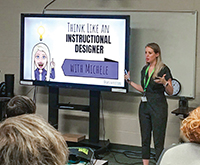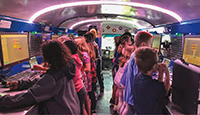
Refining Teachers’ Skills in Digital Reading
School Administrator, May 2020

|
Michele Eaton, director of virtual and blended learning in Wayne Township, Ind., leads professional development for teachers on reading strategies.
|
In Indiana’s Metropolitan School District of Wayne Township, we have worked diligently to provide balanced experiences to our students through both print and digital text.
In our online high school (Achieve Virtual Education Academy) and our blended programs around the district, there is an understandably large focus on digital materials. The virtual and blended learning team works closely with this staff, providing focused professional learning around creating equitable digital reading experiences for our online and blended students.
Our professional learning approach has become highly personalized, giving teachers the time to focus on making meaningful updates to the digital materials used in their courses. We began by dissecting the research shared in this article (and more) on how our students are likely to engage with digital text. First understanding the differences in how we read online versus print materials is important to begin designing activities that help our students effectively and deeply comprehend online text.
The next step in our staff training was to create multiple ways for our teachers to explore various digital reading strategies. The online and blended learning staff in Wayne Township self-selected professional learning that interested them. This learning took the form of online modules, immersion in text using the reading strategies, discussions, webinars and face-to-face meetings.
Finally, our teachers were given time and credit for taking that learning and updating their online and blended courses to reflect a more active approach to reading in these online spaces.
As we move forward, this work will only continue to evolve. For our staff development team, it will be important that we continue to model these reading strategies in the online professional learning opportunities that are presented to staff. As we develop and rewrite courses for our district, we will work diligently to ensure that the reading activities designed for students are optimized for the online environment.
— MICHELE EATON

|
Baltimore County School District’s rollout of technology for 115,000 students necessitated shared accountability and sparked major instructional shifts.
|

|
Baltimore County School District’s rollout of technology for 115,000 students necessitated shared accountability and sparked major instructional shifts.
|

|
Baltimore County School District’s rollout of technology for 115,000 students necessitated shared accountability and sparked major instructional shifts.
|

|
Baltimore County School District’s rollout of technology for 115,000 students necessitated shared accountability and sparked major instructional shifts.
|

|
Baltimore County School District’s rollout of technology for 115,000 students necessitated shared accountability and sparked major instructional shifts.
|

|
Baltimore County School District’s rollout of technology for 115,000 students necessitated shared accountability and sparked major instructional shifts.
|

|
Baltimore County School District’s rollout of technology for 115,000 students necessitated shared accountability and sparked major instructional shifts.
|

|
Baltimore County School District’s rollout of technology for 115,000 students necessitated shared accountability and sparked major instructional shifts.
|

|
Baltimore County School District’s rollout of technology for 115,000 students necessitated shared accountability and sparked major instructional shifts.
|

|
Baltimore County School District’s rollout of technology for 115,000 students necessitated shared accountability and sparked major instructional shifts.
|

|
Baltimore County School District’s rollout of technology for 115,000 students necessitated shared accountability and sparked major instructional shifts.
|

|
Baltimore County School District’s rollout of technology for 115,000 students necessitated shared accountability and sparked major instructional shifts.
|

|
Baltimore County School District’s rollout of technology for 115,000 students necessitated shared accountability and sparked major instructional shifts.
|